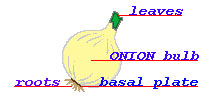Fun Facts
- Originated from area around Iran
- The onion is part of the lily family
- Member of Alliaceae which includes Garlic, Leek, Chives, Scallions, Shallots
- However will not cross with other species for the most part
- Allium Cepa, scientific name
- Have been important part of history, has been cultivated for at least 7,000 yrs
- Egyptians believed onions had strength-producing powers, therefore, they were fed to labors who built the pyramids
- The Romans ate onions to gain strength and courage
- The name onion stems from the Latin word unus meaning oneness or unity
- Alexander the Great ordered his troops to eat onions to improve their vitality
- Stories of Egyptians using onions, Grant's army
- Favorite spice additive to food - has strong flavor
- Americans consumed 18.6 pounds onions /person in 1998
- Diced and cooked in dishes, by themselves, onion rings, awesome blossoms, eaten raw in salads, dried and used as spice - powder & flakes
- As with many vegetables - onions have many beneficial health qualities
- Has many antioxidant compounds - reduce incidence of cancer antiplatelet activity - prevention of heart attacks
- Very important crop in U.S. in top 5 of fresh vegetables for production, acreage, valve and consumption
- Main growing areas - Oregon, Idaho, Washington, California, Michigan, NY, Texas, Georgia, New Mexico, Colorado, Utah
- Northern latitude states grow storage onions - harvested in Sept. & Oct., stored & sold from Sept. to March
- Southern latitude states grow fresh - market onions shipped immediately, sold from March to August
What Causes An Onion to Bulb?
Bulbing in onions primarily controlled by photoperiod - day length - as the days become longer, plants begin to bulb - some cultivars required shorter days to bulb than others.
Hours needed to begin bulbing used to classify cultivars:
- 8-12 hours - short-day
- 13-14 hours - intermediate-day
- 15+ hours - long-day
Southern states grow short-day onions. As the northern latitude increases, the day length requirement for bulbing increases. During the summer months, northern latitudes will have longer day-lengths than southern latitudes. Need to prevent bulbing in order to get large plant otherwise small plant, small bulb. Long-day cultivars at northern latitudes grow longer before bulbing than short-day cultivars. Conversely, Long-day cultivars grow in southern latitudes never reach critical day-length for bulbing so grows a large plant with out bulbing. For a better understanding, visit the Onion's Story page.
What Is A Bulb?
A collect of swollen basal portions of emerged leaves and swollen hidden leaves. The plant stores carbohydrates in the bottom portions of leaves storage initiated by day length.
- Onion has a very short stem
- Actually called the stem basal plate
- From the bottom of plate - roots emerge
- From the top of plates - leaves emerge
- Mostly see the leaves of the plant

Onion cultivars are often grouped by shape and certain markets and growing areas prefer a certain type of onion:
- Globe Northern areas & Northeast
- High globe sweet Spanish type Northwest
- Granex Georgia
- Grano TX, NM, CA
For a better understanding, visit the Onion's Story page.
How Does An Onion Become Sweet?
"It's a long process. It took us about 15 years to develop these," said Marisa Wall, associate professor of horticulture, plant breeder of the sweet onion at New Mexico State University. "Breeding for sweet is a difficult process which requires proper soil, meaning low sulfur and proper climate. Las Cruces' climate is ideal for growing. But the primary factor is genetic in getting to a sweet onion."
Comparison of NuMex vs. Vidalia of Georgia
"It's as mild as the Vidalia, which means low pungency," Wall said. "We breed for that low pungency. The lower the pungency, the easier it is to taste sweetness. Ours are as good if not better than Vidalia. The NuMex is a very mellow onion. I use them on everything. I eat them fresh in salads and in stir fries."
Hints on Not Crying
- To chop, cut or slice an onion with out crying, place onion in freezer for a few minutes before cutting
- Or cut them under water
- For more hints, check-out the tips on our Recipes & Tips page.
Misconception Explained
The color of an onion has nothing to do with its pungency. It's the breeding that counts. And onions can be breed for sweetness or pungency.